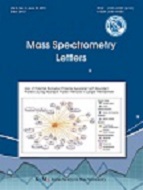
- P-ISSN 2233-4203
- E-ISSN 2093-8950

The fragmentation statistics of ion trap CID (Collision-Induced Dissociation) spectra using 87,661 tandem mass spectra of doubly charged tryptic peptides are analyzed here. In contrast to the usual method of using intensity information, the frequency of occurrence of fragment ions, with respect to the position of the cleavage site and the residues at these sites is stud-ied in this paper. The analysis shows that the frequency of occurrence of fragment ion peaks is more towards the middle of the peptide than its ends. It was noted that amino acid with an aromatic and basic side chain at N- & C- terminal end of the peptide stimulates more peaks at the lower end of the spectrum. The residue pair effect was shown when the amide bond occurs between acidic and basic residues. The fragmentation at these sites (D/E-H/R/K) stimulates the generation of the y-ion peak. Also, the cleavage site H–H/R/K stimulates the generation of b-ions. K-P environment in the peptide sequence has more tendency to gen-erate y-ions than b-ions. Statistical analysis helps in the visualization of the CID fragmentation pattern. Cleavage pattern along the length of the peptide and the residue pair effects, enhance the knowledge of fragmentation behavior, which is useful for the better interpretation of tandem mass spectra.
Aebersold, R. (2003). . Nature, 422, 198-.
Diament, B. (2011). . J. Proteomics, 10, 3871-.
Dancík, V. (1999). . J. Comput. Biol, 6, 327-.
Huang, Y. (2008). . J. Proteome Res, 7, 70-.
Wysocki, V. H. (2000). . J. Mass Spectrom, 35, 1399-.
Boyd, R. (2010). . J. Am. Soc. Mass Spectrom, 21, 1275-.
Kapp, E. A. (2003). . Anal. Chem, 75, 6251-.
Elias, J. E. (2004). . Nat. Biotechnol, 22, 214-.
Huang, Y. (2005). . Anal. Chem, 77, 5800-.
Tabb, D. L. (2003). . Anal. Chem, 75, 1155-.
Martin, D. B. (2005). . Anal. Chem, 77, 4870-.
Schütz, F. (2003). . Biochem. Soc. Trans, 31, 1479-.
Raulfs, M. D. M. (2014). . J. Am. Soc. Mass Spectrom, 25, 1705-.
Rodriguez, J. (2008). . J. Proteome Res, 7, 300-.
Lau, K. W. (2009). . Rapid Commun. Mass Spectrom, 23, 1508-.
Allen, J. M. (2008). . J. Am. Soc. Mass Spectrom, 19, 1764-.
Medzihradszky, K. F. (2015). . Mass Spectrom. Rev, 34, 43-.
Khatun, J. (2007). . Anal. Chem, 79, 3032-.
Loo, J. A. (1993). . Anal. Chem, 65, 425-.